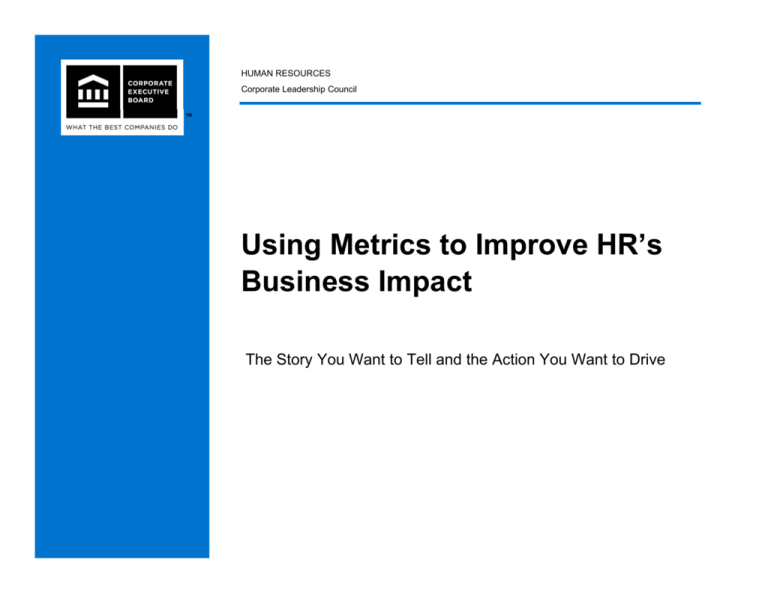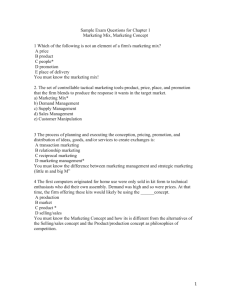
HUMAN RESOURCES
Corporate Leadership Council
™
Using
g Metrics to Improve
p
HR’s
Business Impact
The Story You Want to Tell and the Action You Want to Drive
HR most effectively
drives its strategic
effectiveness through
three critical
communication
behaviors.
• “Insight” relies on the use of
data-driven business
information and a deep
understanding of business
operations to develop tailored
solutions.
• “Influence” on the line starts
with clearly setting service
expectations, articulating a
strong point of view,
maintaining an enterprise
viewpoint, and
communicating relevant
information.
• “Accountability” for outcomes
entails the completion and
communication of predefined
objectives and effective
management of human
capital outcomes to deliver
business impact.
Remember: Effective Communication
Matters
Three Categories of Effective HR Communication Behaviors
INSIGHT
INFLUENCE
ACCOUNTABILITY
Use Data-Driven
Business Information
Set Service
Expectations
Be Measured on Completion
of Predefined Objectives
Tailor Solutions
to Business Needs
Communicate
Business-Relevant Information
Be Measured on Business
Unit Human Capital Outcomes
U d t d Business
Understand
B i
Operations
O
ti
Articulate
A
ti l t a Strong
St
Point of View
B M
Be
Measured
d on Business
B i
Unit Financial Performance
Maintain an
Enterprise Viewpoint
2
Why Use Metrics?
PBG measures the quality
and depth of the talent
bench (“strength”), as well
as the health of the
organization’s culture and
work environment
(“health”), to achieve a
holistic talent assessment
for each business unit.
• PBG measures the
number of ready-now
successors per business
unit and the degree to
which the leader shares
talent to focus leaders on
business unit and
organizational-wide talent
outcomes.
Workforce metrics allow HR to drive leader accountability for
talent outcomes.
PBG’s Talent “Strength” and “Health” Scorecard for Individual Business Units (Illustrative)
3
™
Death by Data: The Metrics Challenge
“Organizational
Organizational analysis often overdoes data
collection and underdoes analysis and action. Reams
of data are collected, reports are generated, statistics
are presented; but, because the data remains
unfocused, little action follows.
Data should be turned into action as the diagnosis
process unfolds, that is, as common themes are
identified, as managers with decision-making
responsibility take ownership of the data, and as
alternative
l
i actions
i
are proposed.”
d
Dave Ulrich
Ulrich, Dave, Human Resource Champions: The Next Agenda for Adding Value and
Delivering Results, p. 75, Harvard Business School Press (1997).
What is Standing in Your Way?
Our Goal:
Partner with our internal clients to deliver on the university’s objectives
Obstacles:
5
End-to-End Process for HR Metrics
™
STEP 1:
Select Strategy-Aligned HR Metrics
STEP 2:
Collect and Benchmark Data
STEP 3:
Communicate Results
STEP 4:
Inform Decisions
Align HR metrics with
organization and HR
strategy.
Phase 1:
Select
StrategyAligned HR
Metrics
HR Metrics Process
Phase 2:
Collect and
Benchmark
Data
Phase 3:
Communicat
e Results
Phase 4:
Inform
Decisions
A ti Steps:
Action
St
A ti Steps:
Action
St
A ti Steps:
Action
St
A ti Steps:
Action
St
Assess Business
Requirements for HR
Standardize
Metrics Definitions
Equip HR to
Communicate
Effectively
y
Build HR
Dashboard
Identify
Measurement Areas
Build a Process for
Tracking Metrics
Review Common
HR Metrics
Translate Raw Data
Evaluate Potential
Metrics
Use Internal and
External
Benchmarking
Resources
Identify Audience
for HR Data
Use Data to
Tell a Story
Customize HR
Dashboards
Use Dashboard to
Communicate with
the Line
7
Story Telling with Data
To translate data into
a story
story, HR must
contextualize the
results and identify its
relevance to the
audience.
Three Stages of Story Telling with Data
Stage
g 1:
Setting the Scene
Stage
g 2:
Plot Development
•What is the current state?
•What are the internal and
external factors that
contribute to the challenge?
•How does the current state
compare with the past state
and the goal state?
•How does the current state
compare
p
with external
benchmarks?
•What key metrics need to
be coupled for a complete
understanding of current
state?
Stage
g 3:
Drawing Conclusions
•Why does the data matter?
•What should be the action
steps moving forward?
Incorporate Audience Considerations
During Story Boarding
• Consider how the story should be tailored to the C-suite,
Board of Directors, Finance, HR, and line leadership to
match their motivations and priorities of different
audiences
• Identify critical touchstones and taboos of audiences
• Create unique story versions for each audience
8
Changing The Way We Present Data
How do I present a case for impact?
Do you presentations to stakeholders…
9
What makes a presentation persuasive?
1.
2.
3.
10
The Story You Want to Tell and the
Action You Want to Drive
Often presentations follow a predictable structure that
begins with objectives, provides numerous pages of data,
and then ends with a recommendation.
What these presentations often miss is the NARRATIVE,
the story that compels the audience to listen and react.
11
How to Tell a Compelling Story….
1.
Build the Structure
Identify sequence of information necessary
to obtain buy-in and drive urgency.
2.
y
Create the Storyboard
Sketch how to present the information
in the most persuasive way.
3
3.
Prepare the Presentation/Deck
Create pages that speak to the audience.
4.
Articulate the Narrative
The story you want to tell and the action you want to drive
5.
Script the Presentation
g techniques to make yyour points memorable
Use transitions and enhancing
and compelling.
12
Power of the Plan
Why Structure is So Important
Structure is made up
p of the components
p
that yyou include in yyour
presentation and the sequence in which you present them.
When creating a presentation, it is easy to dive right in and create the
first page, but this may lead to a presentation that fails because it:
– Contains too much information (hiding the critical information);
– Does
D
nott have
h
a llogical
i l fl
flow.
13
14
Don’t Hide the Ball
When structuring your presentation
presentation, you need to take into account the typical audience
retention across time.
The introduction and conclusion are critical opportunities to gain buy-in. That said, you also
need to maintain your audience’s attention during the middle of your presentation.
15
Let it Flow, Let it Flow, Let it Flow
MIDDLE
• Urgent Context: Set the
• Purpose: State
backdrop and drive urgency.
business need and the
recommended action to • Benefits: Stress benefits
meet the need
need.
throughout the presentation.
• Process: Describe the
• Assumptions: Include data
sequence of the
to support the assumptions
presentation;; set the
p
one would need to believe
expectations of the
to accept the recommended
audience.
• Payoff: Let the audience action.
know what to expect
from the presentation.
INTRODUCTION
CONCLUSION
• Resolution: Summarize how
the recommended action will
achieve business need.
• Action Plan: Drive action by
recommending next steps and
assigning responsibility
16
On the Edge of their Seats
How can I increase retention throughout the presentation?
To keep interest and retention throughout your presentation, you should
incorporate
p
the following
gp
principles:
p
What is in it for me?
Focus on benefits not just features
Why should I act now?
Drive urgency
Prove it!
Assumptions and Data: what do they need to believe to support your recommended
action?
17
18
19
20
APPENDIX
21
Translate raw data
using formulas and
ratios to yield greater
meaning and insight.
ACTION STEP:
TRANSLATE RAW DATA
Types of Formulas to Express Raw Data
• Raw data identified through
the cascading process
described in Step 2 can be
expressed “as is,” but can
yield greater meaning and
insight when expressed in
relation to other measures or
data, such as time, employee
population, expense, etc.
• Developing these
correlations through formulas
can reveal volume, cost,
time, satisfaction, and quality
information.
(For
example, companies often
express the number of
terminations in relation to
overall headcount to
understand the rate at which
employees leave the
organization )
organization.)
Formula Type
Example
RATE
Proportion of one or more
parts to a whole of 100%
• Turnover Rate—[Terminations / Average Headcount] x 100
• Applicant Interview Rate—[Applicants Interviewed / Total Applicants] x 100
RATIO
One number relative to
another, often expressed
as a reduced fraction
• Applicant Ratio—Applicants / Offers Accepted
• Average Time-to-Fill—Total Days to Fill a Position / Offers Accepted
COMPOSITION
Breakdown of a whole
into its parts, showing the
percentage
g
number or p
allocated to each
• Direct Compensation Breakdown—[Compensation Type (i.e., variable pay,
overtime, base pay) / Direct Compensation Expense] x 100
• HR Expense Breakdown—[HR function Expense (i.e., Benefits
Administration Payroll
Administration,
Payroll, Staffing) / Total HR Expense] x 100
INDEX
Weighted combination of
disparate data into one
number relative to a
scale or anchor
• New Hire Performance Satisfaction—An indication of how well recent hires
are performing within their position, based on internal survey results.
• Manager Quality Index—A relative measure of employees’ perceptions of
manager quality as determined by internal survey results.
22
Analyze metrics by
employee segment and
organizational grouping
to direct action
planning.
• The relevance and
usefulness of measurement
results can be greatly
improved if segmented by
particular employee
populations or business unit
groupings.
i
• Understanding how results
differ across various
populations or areas of the
organization can help to
isolate high-impact targets
f intervention
for
i
i and
d reveall
behavioral patterns across
the workforce.
ACTION STEP:
TRANSLATE RAW DATA (CONTINUED)
Segmentation Categories for Measurement Analysis
Dimension
Example
ORGANIZATIONAL STRUCTURE
Segmenting the workforce according
to reporting relationships within
departments and business units
•
•
•
•
Financial reporting
Geographic location
HR responsibility
Supervisory reporting
DEMOGRAPHICS
Segmenting the workforce according
to individual characteristics
•
•
•
•
Age
Education level
Ethnicity
Gender
EMPLOYMENT LEVELS
Segmenting the workforce according
to seniority
• Employment level (e.g., exempt/non-exempt or
hourly/salaried)
• EEO job category
• Manager level
• Compensation band
• Annual salary
FUNCTION
Segmenting the workforce according
to types of jobs performed
• Employment type (e.g., regular/temporary)
• Job family
• Job title
EMPLOYMENT EXPERIENCE
Segmenting the workforce according
to an individual’s experiences at the
organization
•
•
•
•
Benefits participation
Organization tenure
Performance ratings
Position tenure
23
The Council is equipped
to help HR compare
internal data to external
benchmarks.
ACTION STEP:
IDENTIFY EXTERNAL BENCHMARKING RESOURCES
CLC HR Performance Benchmarking Suite
CLC Turnover Database
24
CORPORATE EXECUTIVE BOARD
WWW.EXECUTIVEBOARD.COM
™
From the CORPORATE LEADERSHIP COUNCIL ®
of the HUMAN CAPITAL PRACTICE www clc executiveboard com
www.clc.executiveboard.com
© 2009 The Corporate Executive Board Company. All Rights Reserved. CATXXXXXXXXXX









